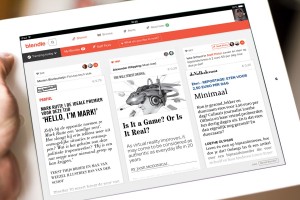Many people are worried about the disappearance of the printed press and quality journalism due to the spread of digital world and the increasing popularity of social websites.
It should therefore be justified to ask if there is a reason for the existence of real and high-standard contents, while uncontrolled „news” including unreal information and funny or rather embarrassing videos are almost spontaneously spread by themselves on the social websites.
Both the publishers and the journalists try to hold on and properly react to this new situation; Kreatív also deals with this topic, and with good reason.
Several publishers choose the strategy of publishing the best articles of their journalists free of charge. Costless stories generate a large circulation that produces profit through the advertisements. However, more and more publishers recognize that their business model cannot be based on this method. Value of their income originating from advertisements has a decreasing tendency, and the competition with Facebook and Google seems to be too strong for many of them. For that very reason, many publishers think that paywall, the so-called paying or payment wall, or production of subscribers’ content will be the solution.
The so-called “meter” model – established and used by the New Your Times since 2011 – may be viable on the large markets of the large publishers. The essence of this model lies in publishing some articles free of charge on their website while you have to pay for the others.
The German Bild uses the so-called “freemium model”; many contents are free for the readers, but the really interesting and special articles are only available for the subscribers. These articles are marked with Bild + logo and you have to pay 5 EUR per month for them.
Practice of the Financial Times and The Times is the best example of “hard paywall” which is the most radical solution. All online articles can be read against payment. This model can work if the readers really want to read the content of the really large newspapers. Most people immediately leave the site after 3 seconds.
A common feature of these three models is that they try to recruit subscribers. Looking at things from the publishers’ point of view, if a newspaper has many subscribers everything is alright. Though the majority of people do not want to pay for the contents on the web, publishers increasingly force their readers to subscribe and pay. Many people hate paywalls, because they have to register again and again at each newspaper or magazine, and pay monthly fees, while they are not really interested in lots of articles.
 Blendle, the Dutch startup has come up with an innovative idea. According to them journalism must offer higher customer experience. They had a thought what if
Blendle, the Dutch startup has come up with an innovative idea. According to them journalism must offer higher customer experience. They had a thought what if
- the readers could read all newspapers important for them in one place;
- they had to register only once to read these newspapers;
- they had to pay only for the articles they had really read;
- they got their money back, if they did not like a particular article;
- there were no subscription fees;
- there were no advertisements.
Well, exactly this idea was implemented in the Netherlands. Blendle is not about consuming less and paying less; but it is rather about reading and paying with one click. It is about providing the highest possible user experience, a good example of which is the money reimbursement guarantee. And in addition, it is about how to support the readers to find the quality articles that are the most important ones for them.
Without spending a single Euro for marketing, Blendle conquered 250,000 users over a year. It is a secret, how much money was earned by them, but it is sure that they earned a lot – more than Apple produces for the publishers. But what is more important than the exact amount: this money came from those people who had never paid for online articles before. Through the Blendle services now they pay for the articles, often for the first time in their life.
Blendle’s experiences from the last year
- Micropayment can work at online articles but not at the news
People spend no money for things that are available to them free of charge, in another place. However, they pay willingly for background information, larger analysis, opinions and longer interviews.
- Their users punish them for the tricky headlines with money reimbursement
As readers are willing to pay only for the contents that they consider to be valuable, quality journalism comes more and more to the fore at Blendle.
- Micropayment and money reimbursements represent a new quality index number
Publishers measured their performance on the basis of page views over the last 20 years. Then many publishers began to measure the time spent on a particular page instead of the number of page views. In the Netherlands journalists may measure the quality of their articles on the basis of two, new important index numbers:
- how much revenue was generated by their articles with micropayments?
- how many persons asked for the return of the money paid, after having read their articles?
- Revenue from micropayments is an additional income
A year ago, some Dutch publishers were scared that launch of Blendle might result in cancellation of the subscriptions. Today it is obvious that Blendle does not attract the current subscribers, but rather those who now pay nothing. In the future they will work together with the publishers in order that they integrate Blendle to their applications and homepages.
Blendle has been about the international spread for two years. We will see if this model works only among the Dutch people, or there is really something special in it.
